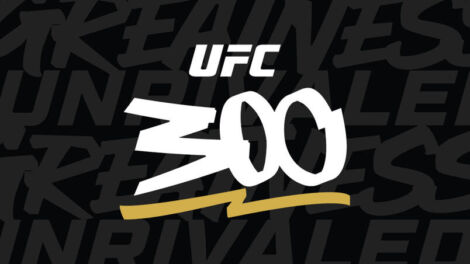
Image via ufc.com
Cal Poly Pomona (CPP) offers many martial arts programs, both for academic credit through the Kinesiology department and via the Bronco Recreation and Intramural Complex (BRIC, Bldg. 42) through Associated Students Inc. (ASI). However, just a few days from now, athletes who have dedicated their lives to learning many of the same combat sports will compete in one of the most-hyped mixed martial arts (MMA) events in history. Ultimate Fighting Championship (UFC) will host UFC 300 on Saturday, April 13, and in preparation for that, here are the basics of MMA, the UFC, and UFC 300 itself.
What is MMA and what are its rules?

Image via forbes.com
MMA is the abbreviation for mixed martial arts, which is a combat sport that utilizes several different martial arts disciplines, including but not limited to kickboxing, wrestling, Brazilian jiu-jitsu, and sambo. Per the official UFC website, MMA can trace its roots back to the Olympic sport of Pankration, which was introduced in 648 BC. Modern MMA began with the creation of Brazilian vale-tudo, which was touted as an “anything goes competition.”
Fights are typically held in elevated rings that utilize ropes and padded posts as boundaries, or a cage, which is usually circle, hexagonal, or octagonal in shape and bordered by fencing on all sides.
Although rules vary between MMA promotions, most punches, kicks, strikes, submissions, and takedowns are permitted if they do not violate the Unified Rules of Mixed Martial Arts. Such violations include eye gouging, groin shots, intentional strikes to the back of the head, and kicks or knees to a downed opponent (specific to some promotions). Generally, most modern MMA fights are contested over three to five, 5-minute rounds, but more on that later.
Ways to win, lose, draw, and more in MMA

Image via eurosport.com
There are three main ways to win a fight: knockout/technical knockout (KO/TKO), submission, and decision. A victory by knockout is earned when a fighter knocks their opponent unconscious, and where the fight is immediately waved off by the referee. A TKO involves a fighter taking unanswered or unnecessary damage to a point where a referee stops the fight, or a medical stoppage due to a cut or other injury.
Submissions occur when a fighter physically or verbally submits due to a hold, choke, or any other type of submission. A fighter may also submit to strikes, but it can be classified as a TKO or submission depending on the promotion.
Decisions almost exclusively happen when a fight lasts the entire allotted time and rounds that are permitted. Three judges score the fight, with most promotions having judges score each round individually. More information on scoring can be found here, but generally the three judges score based on effective striking, grappling, aggression, and control. On the scorecard, the round winner usually gets a score of ten, while the loser gets a score of nine or lower oftentimes based on damage or dominance. For example, if a judge scores a three– round fight 30-27, it means that the winning fighter won all three rounds (ten points each), while their opponent lost all three (nine points each). Points are also deducted from scorecards for an accumulation of fouls or blatant fouls. If all three judges score the bout for a fighter, it is considered a unanimous decision. Two judges scoring it for one fighter, and the other scoring it for the opposing fighter denotes a split decision. Finally, two judges scoring a bout for one fighter, but the third judge scoring the fight a draw results in a majority decision.
Draws can occur in these scenarios: if all three judges score the fight a tie (unanimous draw), if two judges score the fight a tie while one scores it a victory for one fighter (majority draw), or if two of the judges score the fight a victory for each fighter while the third judge scores the bout a tie (split draw).
Amongst the rare results are disqualifications (DQs) and no-contests. A DQ is when a fighter wins due to excessive and intentional illegal contact by their opponent. A no contest is a result of accidental illegal conduct or a scenario where one or both fighters cannot continue.
Weight classes
To promote fair competition, weight classes are utilized across combat sports, with MMA being no different. Using the example of the UFC, there are several weight classes, ranging from 10-20 pounds from one another. To fight in a weight class, a fighter must weigh in at or under the allotted limit for their class around 24 hours prior to their bout. In order, they are strawweight (115 lbs. limit), flyweight (125 lbs.), bantamweight (135 lbs.), featherweight (145 lbs.), lightweight (155 lbs.), welterweight (170 lbs.), middleweight (185 lbs.), light heavyweight (205 lbs.) and heavyweight (265 lbs.). In the UFC, the women’s divisions are strawweight to featherweight, while the men’s divisions include flyweight and higher.
Now that the basics rules and scoring of MMA have been outlined, here is an introduction to the hosts of this weekend’s fight card, the UFC. Formed in 1993 as a one-night event tasked with “finding the ultimate fighting champion,” the UFC has since rose to prominence as the top American MMA promotion, and in the eyes of many, the top MMA promotion on the world.
What is the UFC?

Image via britannica.com
Like all recognized promotions, the UFC follows the Unified Rules of MMA but has several differences from other promotions. First, unlike ONE Fighting Championship and the now defunct Pride Fighting Championship, the UFC does not allow kicks or knees to the head of a grounded opponent. Also, UFC fights are held in the trademarked “octagon”, which like its name implies is an eight-sided cage.
Since its one-night event in 1993, the UFC has seen unprecedented success in the sport of MMA. The promotion is now broadcast in 164 countries and 1.1 billion households in total, even fighting across 29 countries and 5 continents.
As it has grown in popularity, the Las Vegas-based promotion has produced several legends of the sport, including “Rowdy” Ronda Rousey and Georges “Rush” St. Pierre, who have both found success beyond the UFC. Perhaps the most iconic is Irish superstar “The Notorious” Conor McGregor, who has captured the UFC Featherweight and Lightweight Championships while fighting in the octagon.
UFC 300: Why is it so important?

Image via cbssports.com
“300” may seem like just a number tacked onto the UFC banner, but in the grand scheme of the promotion’s history and MMA history, the number could not have more meaning. UFC 300 marks the UFC’s 300th pay-per-view and numbered event in company history, providing a historic milestone for the MMA world. Countless fighters have come and gone in the 30 plus years since UFC 1, and the MMA landscape has changed, with various disciplines being brought to the forefront of the sport, while the sport itself has become more recognized and legalized across the world.
If the history and meaning is not enough, the fight card itself is seen as one of the greatest of all time. On this card alone, 12 current or former champions will fight, which is more than 11 percent of total champions in the company’s history. Even the first bout of the night is between two former champions. The night will be capped off with three title fights, with the main event being contested between Alex “Poatan” Pereira and Jamahal “Sweet Dreams” Hill for the UFC Light Heavyweight title. That said, here’s a rundown of the top matchups and fighters to look out for.
Alex “Poatan” Pereira vs Jamahal “Sweet Dreams” Hill (UFC Light Heavyweight Championship)
Zhang “Magnum” Weili vs Yan Xiaonan (UFC Women’s Strawweight Championship)
Justin “The Highlight” Gaethje vs Max “Blessed” Holloway (BMF Title)
Fight card information can be found here.
The Future is Now
Amongst the established names fighting on UFC 300, there are a fair share of rising stars looking to add to their resumes as they begin their march towards a UFC title. Former NCAA Division I wrestling champion Bo Nickal looks to add onto his undefeated record by taking down Cody Brundage. Meanwhile, rising featherweights “Super” Sodiq Yusuff and Diego Lopes fight against one another, hoping to move up the division ladder.
One of one
Fans tuning into the early prelims will get to see a historic UFC feat that can never happen again. Lightweight veteran Jim “A-10” Miller looks to use his knockout power and high-level ground game to defeat fellow longtime lightweight Bobby “King” Green. Miller, one of the promotion’s longest tenured fighters, would be the first and only person to fight on UFC 100, 200 and 300 upon the completion of his bout. “A-10” defeated Mac Danzig and “The Fireball Kid” Takanori Gomi at UFC 100 and 200 respectively.
The First Fight
The sheer talent of UFC 300 is immediately on display in the night’s first fight. Former flyweight champion Deiveson Figueiredo clashes with former bantamweight champion Cody “No Love” Garbrandt to open the card. Both fighters possess one-punch knockout power and an aggressive style, so seasoned and new fans alike will see what the UFC has to offer right from the get-go.
How to watch UFC 300
The early prelims (first five fights) are broadcast on UFC’s streaming service, UFC Fight Pass, starting at 3 p.m. The prelims (next four fights) can be found on ESPN or ESPN+ with a start time at 5 p.m. Finally, the main card (the final five fights) is streamed exclusively on ESPN+ pay-per-view.
In terms of pricing, watching the entire card may seem expensive. A monthly subscription to UFC Fight Pass is $9.99 a month, while a subscription to ESPN+ is $10.99 a month, with the pay-per-view itself costing $79.99. Fortunately, many TV and streaming platforms carry ESPN, and there are other methods to watch this event other than buying the entire card and subscriptions on your own. The UFC website has a search engine that allows for fans to find local restaurants that broadcast the entire UFC card. Another option is to catch the main card at a local movie theater. AMC will broadcast the fight at several local theaters and tickets can be purchased here.
Final note
UFC 300 looks to be a landmark event for new and old fans alike. Though MMA may seem complicated at first, it is truly a unique sport to watch, that brings together athletes of many different backgrounds. If UFC 300 is your first fight card, you will not be disappointed; the level of talent on display may be greater than any other fight night in history.
Will you tune in to watch UFC 300, and who are your picks for each fight? Let us know on our social media @ASICPP on Instagram, Facebook, YouTube, and TikTok!



